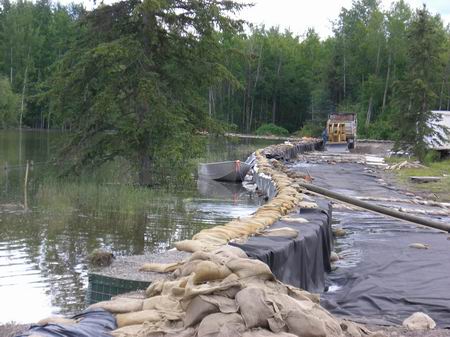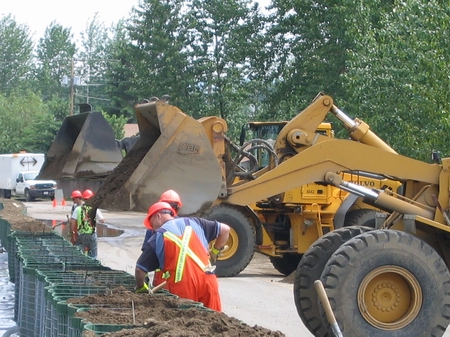Special Diking System Gets Credit for Holding Back Nechako
By 250 News

Gabion Dike set up along the bank of the Nechako river in Vanderhoof (Photo Opinion250 archive)
Heading into the spring freshet of 2007, the Province made one purchase, which seems to have paid off big time.
Gabion Dikes.
It was the first year that technology was used in the province. “If you need it in a hurry, you can put it up in a hurry” says the Minister for Public Safety and Solicitor General John Les.
He says when he first heard of the product he thought it would be a good idea for B.C. “So we bought 10 kilometres of it this year, it is supposed to be reusable so we will learn from it this year if it is, and to what extent it is, but if its not, I think that for the price, the 10 kilometres cost us about $1.5 million dollars, we saved ourselves way in excess of that in damage claims alone.” 
Although a stretch of gabion dike was set up on River Road in Prince George during the flood crisis in June, the dike didn't face the kind of test it would undergo in the community of Vanderhoof. ( at right dikes being set up along River Road in Prince George photo Opinion250 archive)
In Vanderhoof, the Gabion Dikes, fortified with sandbags, held back the Nechako River for nearly two months.
Provincial Emergency Program Direct or of Operations, Jim Whyte says the Gabion Dikes wasn’t designed for flood situations at all “Originally, the system was developed for use by the military. You could set them up around your encampment, fill them full of rocks and no one could shoot through them.” Whyte says when lined with a special fabric and filled with sand, the gabion dike becomes an effective line of protection from flood waters.
Whyte says once the Nechako River has receded to normal levels, the dikes will be emptied, washed, dried out and stored for the next emergency.
The Minister for Public Safety / Solicitor General John Les says the dikes were a huge success “It was a great investment I certainly will not hesitate to acquire more of it and make sure it is deployed around the province so it is ready when needed.”
Previous Story - Next Story
Return to Home










